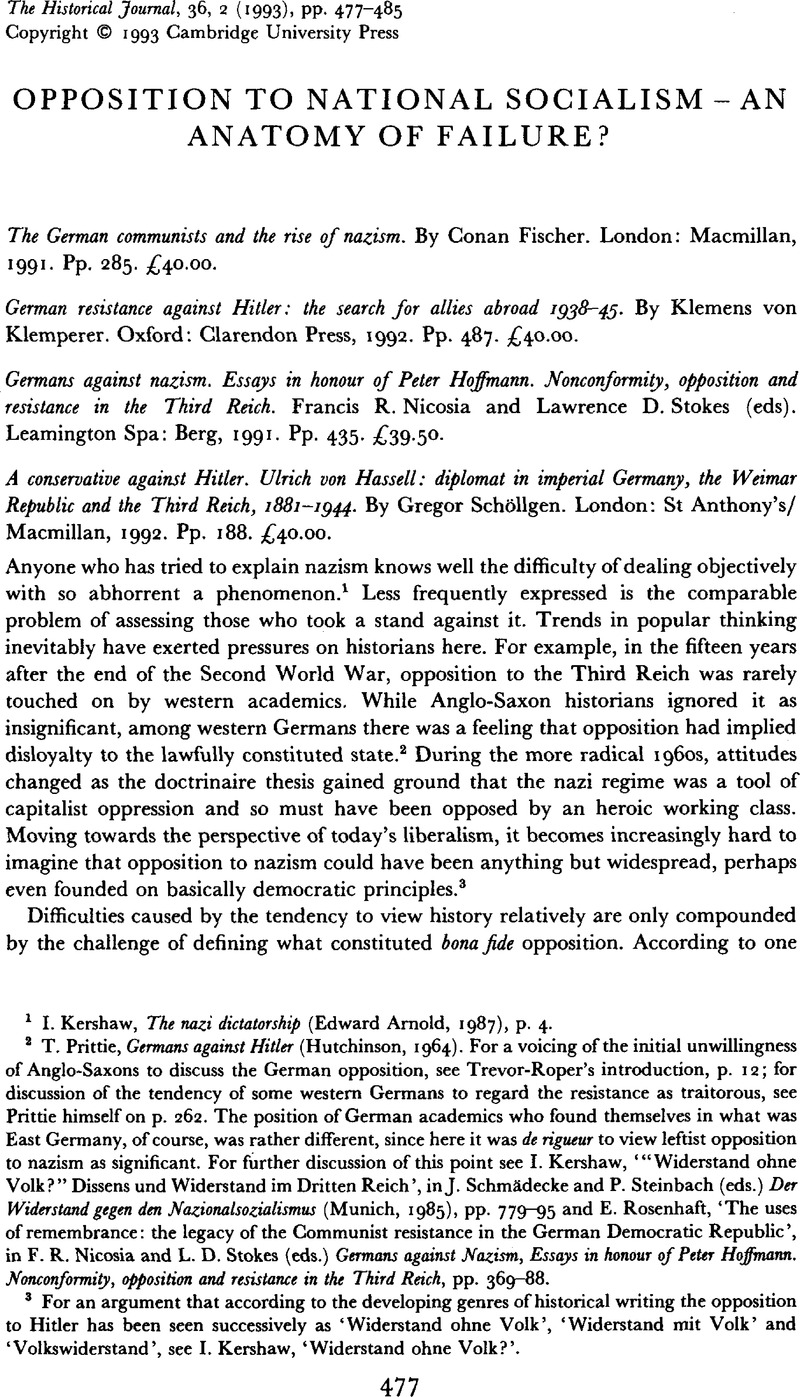No CrossRef data available.
Published online by Cambridge University Press: 11 February 2009

1 Kershaw, I., The nazi dictatorship (Edward Arnold, 1987), p. 4Google Scholar.
2 Prittie, T., Germans against Hitler (Hutchinson, 1964)Google Scholar. For a voicing of the initial unwillingness of Anglo-Saxons to discuss the German opposition, see Trevor-Roper's introduction, p. 12; for discussion of the tendency of some western Germans to regard the resistance as traitorous, see Prittie himself on p. 262. The position of German academics who found themselves in what was East Germany, of course, was rather different, since here it was de rigueur to view leftist opposition to nazism as significant. For further discussion of this point see Kershaw, I., ‘“Widerstand ohne Volk?” Dissens und Widerstand im Dritten Reich’, in Schmadecke, J. and Steinbach, P. (eds.) Der Widerstand gegen den Nazionalsozialismus (Munich, 1985), pp. 779–95Google Scholar and Rosenhaft, E., ‘The uses of remembrance: the legacy of the Communist resistance in the German Democratic Republic’, in Nicosia, F. R. and Stokes, L. D. (eds.) Germans against Nazism, Essays in honour of Peter Hoffmann. Nonconformity, opposition and resistance in the Third Reich, pp. 369–88Google Scholar.
3 For an argument that according to the developing genres of historical writing the opposition to Hitler has been seen successively as ‘Widerstand ohne Volk’, ‘Widerstand mit Volk’ and ‘Volkswiderstand’, see I. Kershaw, ‘Widerstand ohne Volk?’.
4 Kershaw, I., Popular opinion and political dissent in the Third Reich: Bavaria 1933–45 (Oxford, 1983). p. 3Google Scholar.
5 For more talk of dictionary definitions see Nicosia, F. R., ‘Introduction: resistance to National Socialism in the work of Peter Hoffmann’, in Nicosia, and Stokes, (eds.) Germans against nazism, p. 1Google Scholar.
6 Fischer, C. ‘Class enemies or class brothers ? Communist-Nazi relations in Germany 1929–33’, European History Quarterly, XV (1985), 259–79CrossRefGoogle Scholar. For the ensuing debate with Dick Geary, see the same volume pp. 453–71.
7 The contentious nature of the crossover notion is not affected by the now well established fact that the NSDAP did have many supporters from at least some segments of the working classes. See, for example, Hamilton, R. F., Who voted for Hitler? (Princeton, 1982)CrossRefGoogle Scholar. It is Fischer's dynamic angle that is at issue. For a study of nazi-communist relations from the perspective of streetfighting, see Rosenhaft, E., ‘Working class politics: communists, nazis and the state in the battle for the streets, Berlin 1928–32’, in Bessel, R. and Feuchtwanger, E. J. (eds.), Social change and political development in Weimar Germany (London, 1981)Google Scholar.
8 Stachura, for example, presents the choice facing German youth as one of internationalism versus nationalism. Stachura, P. D., The Weimar Republic and the younger proletariat, an economic and social analysis. (London, 1989), p. 155Google Scholar. In the subsequent pages, he goes on to argue that the political allegiance of the young was based more on emotional than ideological radicalism (p. 159).
9 It may be, for instance, that the ‘United Front from Below’ effectively amounted to the minor side of a ‘dual track’ policy forced on the KPD. Equally it may prove that, on the larger scale, only a relatively few, particularly volatile, workers were persuaded to cross over.
10 Most notably Hoffmann, P., The history of the German resistance 1933–45 (London, 1977)Google Scholar.
11 In Nicosia and Stokes, Germans against nazism, L. E. Hill discusses the national conservative opposition before 1939, H. C. Deutsch the Munich crisis, H. O. Malone Adam von Trott, and R. A. Blasius the British reaction to German peace-feelers.
12 The Abivehr was Germany's military intelligence organization.
13 von Klemperer, K., German resistance against Hitler: the search for allies abroad 1938–1945 (Oxford, 1992)Google Scholar, preface.
14 Ibid. p. 249–50.
15 Ibid. p. 321–2.
16 Ibid. p. 331–2.
17 Ibid. p. 11–12. George Bell was bishop of Chichester, Willem Visser't Hooft was General Secretary of the World Council of Churches.
18 Hoffmann's The history of the German resistance 1933–45 highlights Haider as one of the most fascinating, if frustrating characters of the German resistance. He is well worth biographical study. Of his involvement in pre-war resistance activity, Hoffmann comments that perhaps it ‘was no more than the normal action of a General staff officer in providing a contingency plan which was then pigeonholed when no executive order arrived…’ (p. 127).
19 Schöllgen, G., A conservative against Hitler. Ulrich von Hassell: diplomat in Imperial Germany, the Weimar Republic and the Third Reich 1881–1944, p. 56Google Scholar.
20 Ibid. pp. 99–100.
21 Von Klemperer, , German resistance against Hitler, p. 6Google Scholar and G. Schöllgen, A conservative against Hitler, ch. 9.
22 Dirks, W., ‘Katholiken zwischen Anpassung und Widerstand’, in Löwenthal, R. and von zur Mühlen, P. (eds.), Widerstand und Verweigerung in Deutschland 1933 bis 1945 (Cologne, 1982), p. 140Google Scholar.